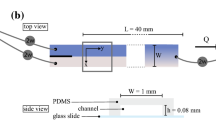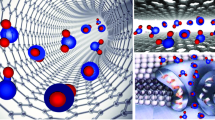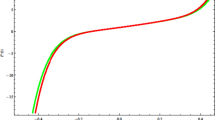Abstract
Molecular dynamics simulations are performed to understand the characteristics of the one-dimensional Brownian motion of water columns inside carbon nanotubes (CNTs) at room temperature. It is found that the probability of 2–10-nm-long water columns sliding a distance larger than the energy barrier period inside 2–5-nm-diameter CNTs is greater than 50 %. Moreover, a conservative estimation gives that the thermal fluctuation-induced driving force exceeds the upper bound of the sliding energy barrier for a water column shorter than 117 nm. These findings imply that although water molecules form layered structures near the CNT inner walls, there is no critical interfacial shear stress to conquer, and water could slip inside CNTs under any given pressure drop due to the thermal activation at room temperature.








Similar content being viewed by others
References
Barthlott W, Neinhuis C (1997) Purity of the sacred lotus, or escape from contamination in biological surfaces. Planta 202:1–8
Berendsen HJC, Grigera JR, Straatsma TP (1987) The missing term in effective pair potentials. J Phys Chem 91:6269–6271
Chen X, Cao GX, Han AJ, Punyamurtula VK, Liu L, Culligan PJ, Kim T, Qiao Y (2008) Nanoscale fluid transport: size and rate effects. Nano Lett 8:2988–2992
Chen C, Ma M, Jin K, Liu JZ, Shen L, Zheng Q, Xu Z (2011) Nanoscale fluid-structure interaction: flow resistance and energy transfer between water and carbon nanotubes. Phys Rev E 84:046314
Gonzalez MA, Abascal JLF (2010) The shear viscosity of rigid water models. J Chem Phys 132:096101
Hardy DJ, Stone JE, Schulten K (2009) Multilevel summation of electrostatic potentials using graphics processing units. Parallel Comput 35(3):164–177
Holt JK, Park HG, Wang YM, Stadermann M, Artyukhin AB, Grigoropoulos CP, Noy A, Bakajin O (2006) Fast mass transport through sub-2-nanometer carbon nanotubes. Science 312:1034–1037
Hoover WG (1985) Canonical dynamics: equilibrium phase-space distributions. Phys Rev A 31(3):1695–1697
Kadanoff LP (2000) Statistical physics: statics, dynamics and renormalization. World Scientific. http://www.worldscientific.com/worldscibooks/10.1142/4016
Ma MD, Shen L, Sheridan J, Liu JZ, Chen C, Zheng Q (2011) Friction of water slipping in carbon nanotubes. Phys Rev E 83(3):036316
Majumder M, Chopra N, Andrews R, Hinds BJ (2005) Nanoscale hydrodynamics—enhanced flow in carbon nanotubes. Nat 438(7064):44
Markesteijn AP, Hartkamp R, Luding S and Westerweel J (2012) A comparison of the value of viscosity for several water models using Poiseuille flow in a nano-channel. J Chem Phys 136:134104
Martini A, Hsu HY, Patankar NA, Lichter S (2008) Slip at high shear rates. Phys Rev Lett 100:206001
Mo H, Evmenenko G, Dutta P (2005) Ordering of liquid squalane near a solid surface. Chem Phys Lett 415:106–109
Nose S (1984) A molecular dynamics method for simulations in the canonical ensemble. Mol Phys 52:255–268
Pathria RK (1996) Statistical mechanics. Butterworth-Heinemann, UK
Peng XS, Jin J, Nakamura Y, Ohno T, Ichinose I (2009) Ultrafast permeation of water through protein-based membranes. Nat Nanotechnol 4:353–357
Plimpton S (1995) Fast parallel algorithms for short-range molecular-dynamics. J Comput Phys 117:1–19
Stone HA, Stroock AD, Ajdari A (2004) Engineering flows in small devices: microfluidics toward a lab-on-a-chip. Annu Rev Fluid Mech 36:381–411
Stuart SJ, Tutein AB, Harrison JA (2000) A reactive potential for hydrocarbons with intermolecular interactions. J Chem Phys 112:6472
Thompson PA, Troian SM (1997) A general boundary condition for liquid flow at solid surfaces. Nature 389:360–362
Werder T, Walther JH, Jaffe RL, Halicioglu T, Koumoutsakos P (2003) On the water-carbon interaction for use in MD simulations of graphite and carbon nanotubes. J Phys Chem B 107:1345–1352
Xiong W, Liu JZ, Ma M, Xu ZP, Sheridan J, Zheng QS (2011) Strain engineering water transport in graphene nanochannels. Phys Rev E 84:056329
Xiong W, Liu JZ, Zhang ZL, and Zheng QS (2013) Control of surface wettability via strain engineering. arXiv:1304.4770
Yang F (2009) Slip boundary condition for viscous flow over solid surface—a rate process. Chem Eng Commun 197:544–550
Acknowledgments
L.S. acknowledges the financial support from the University of Sydney through the International Program Development Fund. Q.Z. appreciates the support by the National Science Foundation of China (NSFC) through Grant No. 10672089, No. 10772100 and No. 10832005, and the 973 Program No. 2007CB936803. The authors are grateful to the computing support from NCI National Facilities in Australia.
Author information
Authors and Affiliations
Corresponding authors
Rights and permissions
About this article
Cite this article
Chen, C., Shen, L., Ma, M. et al. Brownian motion-induced water slip inside carbon nanotubes. Microfluid Nanofluid 16, 305–313 (2014). https://doi.org/10.1007/s10404-013-1247-0
Received:
Accepted:
Published:
Issue Date:
DOI: https://doi.org/10.1007/s10404-013-1247-0




